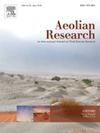The influence of foredune geometry on wind flow quantified from computational fluid dynamics simulations
IF 3.4
3区 地球科学
Q2 GEOGRAPHY, PHYSICAL
引用次数: 0
Abstract
Wind flow over a coastal foredune is driven by a complex interplay of dune geometry, sand transport, and vegetation dynamics. While previous studies have explored the influence of foredune geometry and wind direction on wind flow, their combined effects remain underexplored. This study employs 3D computational fluid dynamics to investigate the impact of foredune height, stoss slope, and incident wind direction on wind flow along the seaward side. Model accuracy was validated against field measurements, then used to simulate wind flow over an idealized foredune with varying heights and slopes across 11 wind directions. Results show that foredune height has the strongest influence on flow speed-up and directional deviations. The highest (25 m) and steepest (1:2) dune experiences the largest speed-up (12) under shore-normal winds, decreasing to 4 for a 1:4 slope and to 1 for alongshore winds. For a 6 m high foredune, speed-up remains around 2, dropping to 1 only for highly oblique winds. Angle deviations across the foredune peak at 30 to 60° wind incidence, and can be up to 20° at the dune toe and crest for the highest and steepest foredune in the simulations. This study demonstrates how combined dune geometry properties – specifically height and slope – along with the incident wind direction influence wind speed-up over foredunes. These findings improve our understanding of sand transport, coastal dune evolution, and artificial dune design, particularly in anticipation of future work that will couple wind flow models with sediment transport models to assess morphological changes under varying wind conditions.
计算流体动力学模拟量化了前丘几何形状对风的影响
沿海前沙丘上的风流是由沙丘几何形状、沙输运和植被动态等复杂的相互作用驱动的。虽然以往的研究已经探讨了前丘几何形状和风向对风流动的影响,但它们的综合作用尚未得到充分的探讨。采用三维计算流体力学方法研究了前丘高度、坡面坡度和入射风向对向海侧风向的影响。通过现场测量验证了模型的准确性,然后用于模拟在11个风向上具有不同高度和坡度的理想前沙丘上的风流。结果表明,前丘高度对水流加速和方向偏差的影响最大。最高(25米)和最陡(1:2)的沙丘在海岸正常风下加速最大(12),在1:4坡度下加速为4,在沿岸风下加速为1。对于6米高的前沙丘,加速保持在2左右,只有在高度斜风时才降至1。在30 ~ 60°风入射角范围内,前沙丘峰顶的角度偏差最大,在最高和最陡的前沙丘峰顶和沙丘脚趾的角度偏差最大可达20°。本研究展示了沙丘的几何特性-特别是高度和坡度-以及入射风向如何影响前沙丘上的风速加速。这些发现提高了我们对沙输运、海岸沙丘演化和人工沙丘设计的理解,特别是对未来将风流模型与泥沙输运模型相结合以评估不同风条件下形态变化的工作的预期。
本文章由计算机程序翻译,如有差异,请以英文原文为准。
求助全文
约1分钟内获得全文
求助全文
来源期刊

Aeolian Research
GEOGRAPHY, PHYSICAL-
CiteScore
7.10
自引率
6.10%
发文量
43
审稿时长
>12 weeks
期刊介绍:
The scope of Aeolian Research includes the following topics:
• Fundamental Aeolian processes, including sand and dust entrainment, transport and deposition of sediment
• Modeling and field studies of Aeolian processes
• Instrumentation/measurement in the field and lab
• Practical applications including environmental impacts and erosion control
• Aeolian landforms, geomorphology and paleoenvironments
• Dust-atmosphere/cloud interactions.
 求助内容:
求助内容: 应助结果提醒方式:
应助结果提醒方式:


